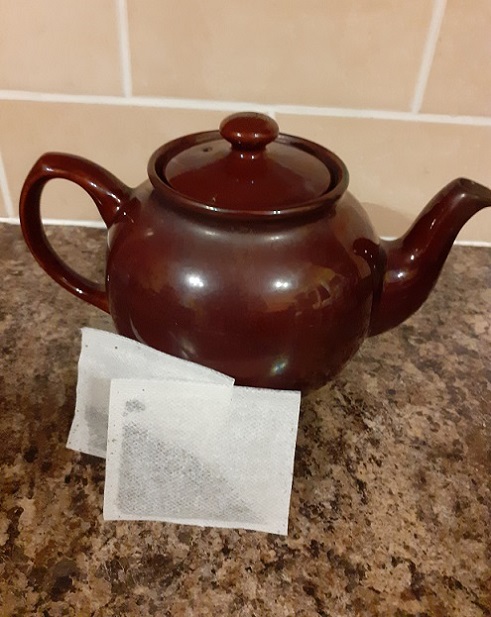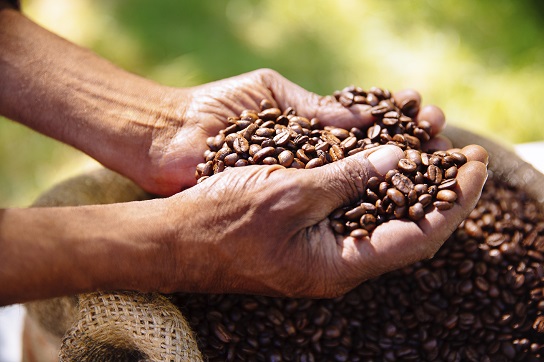 If you’re a coffee aficionado, or even a casual fan, then you might have been confused by the words of your bar’s resident expert.
If you’re a coffee aficionado, or even a casual fan, then you might have been confused by the words of your bar’s resident expert.
He’ll be sitting behind the counter, holding court to a circle of starry eyed admirers, proudly disparaging this or that commercial coffee brand. He’ll be speechifying about how wooden barrels and sun-drying techniques make coffee toxic, polluting its pure essence. He’ll say that he, for one, only buys brands grown above 1000 meters.
What’s he going on about? You might know already – mycotoxins. He’s one of the many people terrified about microbial toxins produced by aspergillus mould species. These toxins are designed to kill bacteria, the mould’s enemy, but they also supposedly wreck human health. Cancer, kidney failure, you name it.
Acne-wise, mycotoxins are proven to increase inflammation and drain your antioxidant supplies.
But is coffee really a problem? Because mycotoxins are invisible, silent molecules, they tend to cause mass panic. They’re also from moulds, which has the ickiness factor. Maybe you’ve been put off coffee entirely, but are trying to give it one last chance.
Proof that mycotoxins are not the end
The happy truth is that for most people, even a commercial cup of coffee will be safe for mycotoxins.
There’s no doubt that mycotoxins have caused acne in the past. Some beans are toxic waste, but the vast majority contain only minuscule levels.
In 2010, some white-coated scientists analysed commercial coffee for sale in France. They walked into a supermarket, purchased roast coffee, walked out, and repeated this 29 more times.
The alkaline-testing method detected significant ochratoxin A in 16-49% of coffee packets, while the acidic found them in 55-60%. Traces of OA were detected in all coffees, but only 1/30 packets exceeded the EU’s legal limit of 5 µg/kg, which achieved 11.9ug/kg. Dodgy batches can clearly happen, but surrounded by harmless ones.
Italy got the same treatment in 2013 (study), with scientists purchasing 30 commercial coffee brands from supermarkets again. That’s why these studies are great; they’re coffees that anyone could buy, on a holiday to Venice perhaps, rather than green bean samples swapping hands in the back corridors of the industry. So anyway, only 8 (26.6%) coffee packets tested positive for ochratoxin. Better, not one was above the EU’s legal limit of 5 ug/kg, and even better, 28/30 red wines came up clean.
Sailing across the Atlantic, things were a little different in Brazil (study). Scientists wandered around a market in São Paulo and purchased 82 instant coffee products. 81 of them tested positive for ochratoxin A.
It sounds horrifying – a mould toxin everywhere you turn – but only 1 sample breached the EU’s legal limit of 5 ug/kg. The average contamination rate was 1.21 ug/kg.
Also, when this study was performed, Brazil had no legal limits on ochratoxin levels in food. The local companies were probably exporting their top dollar beans to stricter western markets while flogging off their barrel-scraping beans to the poor old locals.
No need to exile coffee
 The results are consistent. Maybe 30-50% of commercial coffees contain mycotoxins, but the quantities are a drop in the ocean.
The results are consistent. Maybe 30-50% of commercial coffees contain mycotoxins, but the quantities are a drop in the ocean.
The exception is you have an extreme sensitivity, which undoubtedly exist judging by the horror stories I’ve read. Twitchy muscles, aching joints, and sudden skin breakouts are all classic symptoms. There could easily be an ochratoxin A gene that varies in the unlucky sensitive, like CYP1A2 for metabolising caffeine.
If we were talking pesticides, I’d be much more worried. The safety limits are laughably lax with atrazine and glyphosate, but almost all of coffee’s mycotoxins will be counteracted.
Their signature dark art is decreasing antioxidants, but chlorogenic acid, caffeic acid and ferulic acid will replenish them simultaneously. Despite the mycotoxins, coffee consistently increases bloodstream antioxidants in studies, and it’s the same story for inflammation. Mycotoxins are far riskier in peanuts, for example (namely aflatoxin B), because they lack the bountiful treasure trove of natural antioxidants.
Just as importantly, no man or woman can avoid mycotoxins unless you moved to an Antarctic igloo. The main mycotoxin in coffee is easily ochratoxin A, manufactured by the species aspergillus carbonarius and aspergillus ochraceus (the origin of the name). This mould weapon is also found in raisins, cereals, nutmeg, paprika and ginger. It was once estimated that 99% of humans have ochratoxins in their bloodstream.
The real danger is mycotoxins far above what your body can easily metabolise.
How do moulds enter the harvesting chain?
 There are many opportunities for mycotoxins to hook their claws in, and the first is preharvest.
There are many opportunities for mycotoxins to hook their claws in, and the first is preharvest.
Aspergillus moulds thrive in moisture and temperatures of 19-29C. Almost all beans have tiny levels, but the longer they stay on the plant, the greater the opportunities to take over. In poorer, less educated countries, farmers often mistime their harvest and pick overly ripe beans. They think that they’re maximising their yield, but in the long run, the poor quality will hurt their profits.
Farmers also walk around scooping up beans so ripe that they’ve naturally fallen off the tree – big coffee organisations recommend against this. Sometimes the healthy beans fall off the plants, but then roll into the mouldy ones.
Then we have perhaps the ultimate secret: wet processing vs sun drying, with the latter being mycotoxin mania.
Water processing is efficient to the max. The beans have their outer pulp removed with a machine called a depulper, before being submerged in water and fermented to remove the remaining traces.
Sun drying, meanwhile, is the old school method, as the coffee beans are layed on bricks, bamboo, patios or tables to dry. The more circulating air, the better, and the pulp naturally peels off. Some say that the coffee tastes fruitier, but sun-drying often takes weeks to succeed, and moulds expand by digesting sugars in the pulp like glucose. The longer the pulp stays, the more powerful the mould becomes.
Sun-drying is the favourite of African countries with parched water supplies, and that’s why African coffee generally tests much higher for mycotoxins than South American. It’s also traditional, and many old school farmers cling on to it.
Also, some rural farmers lie their beans on damp wooden platforms to dry, but forget to turn them over regularly, an unskippable trick against mycotoxin overgrowth.
Then there’s a natural villain. Ordinarily, sun-dried coffee beans gain most of their moulds by day 5. The beans dry, but if a sudden rainstorm strikes, the aspergillus can jump on its beloved moisture and return. Amateurish farmers might not be savvy enough to anticipate foul weather and shelter the beans accordingly.
Storage is the most obvious point. If farmers dump their beans in overly warm and damp barrels, without thinking, then the moulds will seize their chance, particularly if they’re languishing for weeks. Containers can be leaky, floors can be wet, or the old wooden farmhouses can be disrepaired and mouldy themselves.
Coffee husks are notoriously contaminated, and some farmers fail to separate them from the beans properly, with small husk fragments swept into the same barrel carelessly. During transportation, they might reuse the same bags from older, mouldier beans, undoing all their hard work with the new batch.
Some argue that farming’s importance is overstated, that certain soils are naturally more contaminated with aspergillus which is absorbed by the tree’s roots. Similar, the coffee berry borer which farmers love to blast with pesticides carries aspergillus naturally, which it might deposit as it lands. However, most scientists agree that harvesting and drying are the pivotal mycotoxin moments.
Pieces of advice from coffee farming organisations include…
ONE: raking drying beans 5-10 times daily.
TWO: having a drying layer of beans no more than 4cm thick.
THREE: never drying coffee beans on bare soil.
FOUR: never processing coffee beans next to a swamp (which seems pretty obvious…).
FIVE: keeping processing equipment very clean.
There’s loads to remember, and even upstanding farmers make mistakes. When you have remote African villages and thick Brazilian rainforests, getting the information out can be impossible.
Some great real world examples
To find out the lay of the land, some international coffee experts decided to go on a mycotoxin world tour.
In 2019, they ventured to distant corners of the coffee universe, to tiny villages inhabited by few and heard of by fewer. They vanished into rainforests and returned with stories of experienced farmers, but also incompetence.
ONE: a Brazilian farm with an inescapable problem. It was located in a natural misty basin, making the storage huts constantly damp and a paradise for moulds. The drying yard was also very small, with coffee beans piled on top of each other, clean and contaminated alike. One coffee sample contained 10µg of ochratoxin A per kg, and another contained 48µg/kg. The farm was located in Northeast São Paulo State, a land of high quality coffee, thanks to elevations of 800-1000m and a low rainfall of 30mm per month.
TWO: a farm in the wetter region of Southwest São Paulo state (65mm monthly). On average, the coffee is poorer than northeast São Paulo, and one farm exemplified it. The farmers were particularly lazy about turning over their coffee beans during drying. It was located in a misty basin again, and the storage barn was ramshackle enough that birds could fly in, and also a very damp barn. A. ochraceus moulds were detected in 30% of coffee bean samples.
THREE: in western São Paulo, where the coffee quality is average, one farm made a fatal error. The bean storage barn was positioned directly behind a coffee dryer, which was injecting hot humid air into the barrels all day long. The temperatures of the beans were extremely high, and one bean contained 10ug/kg of ochratoxin A.
FOUR: another farm in Western São Paulo had a broken coffee bean elevator, which made the dried beans at the bottom mouldy and damp. One sample contained 14ug/kg of ochratoxin A, and had furry grey mould patterns visible on it. This time, they detected aspergillus carbonarius instead of a.ochraceus.
These are classic examples of real world mistakes by farmers. Mycotoxin contamination doesn’t always follow the same rules. One seemingly innocent decision can be the catalyst for mycotoxin mayhem. Sometimes, the farmers are trying their best, but are limited by their equipment and buildings; just look at the small drying yard.
So how come coffee is safe?
 Firstly, there’s simple economics. Most reputable coffee companies do not want to be seen dealing dodgy coffee.
Firstly, there’s simple economics. Most reputable coffee companies do not want to be seen dealing dodgy coffee.
There’s a huge movement in the coffee world right now called the third wave. According to the mystical elders of coffee, the first wave was during the 1800s when coffee gained its massive popularity, when entrepreneurs realised the beverage’s massive potential and starting importing it from faraway lands.
The second wave was the birth of multinational chains like Starbucks in the 1960s. Coffee shops morphed from a place to grab a cup into a popular social gathering spot.
Finally, the third wave is now; it’s people appreciating the subtle flavours of coffee beans as an artisanal craft food.
Like a fine wine, they religiously compare brands and countries of origin for their fine tasting. The subplot is the obsession with quality, like the barista on his high horse about his cousin’s primal new brand. A musty, mouldy cup of coffee has no place in this movement, and companies, whether they truly care or not, always respond to the forces of economics, even if a huge part of their market is simply workers who need to swallow caffeine to complete a late night assignment.
This is complimented by massive natural health websites which bang on about mycotoxins, particularly paleo websites. There’s the supposedly mycotoxin-free bulletproof coffee recipe, with thick globules of butter dropped in, which began life as an internet niche before breaking into the mainstream.
All this piles the pressure on huge coffee corporations. Small rural farmers are getting the message that their services will no longer be required if they serve up moldiness.
There are exceptions of course. Shady hustlers are still around, sneaking in and grinding the cast off beans into something barely palatable but massively profitable. But the movement towards coffee purity is so strong that these companies are losing their reputation. It’s the opposite of olive oil, which is the mafia’s playground and remains more fraudulent than even the Roman era. Somehow, fake olive oil lives on no matter how many newspaper articles expose it.
The roasting shield
The second reason, of course, is the roasting. To unleash the full palette of natural flavours, so that coffee actually tastes like coffee and not a chewy green bean, coffee beans are treated with temperatures of 210-220C.
We discussed here how this obliterates the pesticides which coffee beans are blasted with like chlordane and heptachlor, how it’s a surprisingly safe non-organic food. It’s little different with mycotoxins.
Originally, when ochratoxins were first detected in raw coffee beans in 1974 (they was discovered entirely in 1965), scientists assumed that the heat would erase them. A study in 1994 counteracted that, showing that 87% remained. However, they only roasted the beans for 3 minutes in a laboratory procedure.
Following that, a reassuring 1998 study on 3 tonnes of green coffee found that 16% of the ochratoxin A survived. The clearest study of all (from 2001) observed 69-93% reductions in ochratoxin A after 2.5-10 minutes of roasting.
Even if a farmer is lazing around in a hammock with trained gorillas drying the beans for him (although they might do a better job), the majority of dodgy beans will be salvaged by this unskippable coffee making process.
There’s only one serious worry, one that materialised two years ago. It’s a shadowy figure called 2′R-ochratoxin A. This is the ochratoxin’s dark and disturbed nephew: 2’R-OTA forms during the chemical degradation of ochratoxin during heating. Another breakdown compound is decarboxy-ochratoxin A, but it seems to play second fiddle to 2’R-OTA. A study found that 98% of coffee bean samples contain ochratoxin A, and after roasting, 35% contained 2′R-OTA. One sample contained 0.63 ug/kg (study).
So far, its exact toxic potential is a mystery. It could be a disaster, thinking we’re home and dry by destroying the evil mycotoxin, only to unleash something far worse. This is the only reservation we had about pesticides in coffee; that equally dangerous byproducts might form.
However, there are some positive signs: 2′R-OTA is 10 times less cytotoxic than ochratoxin A (study). The jury is out for now.
The verdict
What swings it is the same undeniable fact as before: that the studies on coffee are anti-inflammatory and pro-antioxidant as far as the eye can see.
If you stagger into a supermarket and grab the first coffee brand in sight, there’s undoubtedly a chance that you’ll be swallowing ochratoxin A two hours later. You could even look in the mirror and see seven new pimples, just before a job interview the next day.
However, even the average coffee brand will be harmless as long as you follow the cornerstone pillars of an acne-clearing diet. Namely, eating more antioxidants and decreasing inflammation, and oh wait: drinking coffee will accomplish that anyway! There’s an inbuilt buffer with coffee and dark chocolate that you don’t have with peanuts, beer, seeds or wheat, other mycotoxin-rich foods.
A warning though: be extra careful with African coffee. Things might have changed, but this 2000 study found that African coffee samples averaged at 4.7ug/kg of ochratoxin A compared to just 0.5ug for South American ones.
You should keep mycotoxins at the back of your mind, but they’re no reason to outlaw this acne-friendly treat.
Thanks for reading!